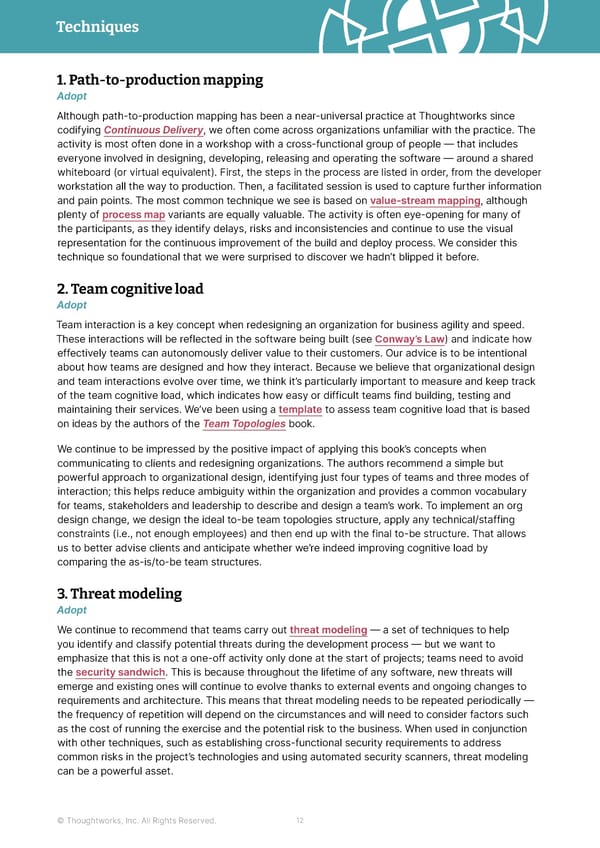Techniques Thoughtworks Technology Radar 1. Path-to-production mapping Adopt Although path-to-production mapping has been a near-universal practice at Thoughtworks since codifying Continuous Delivery, we often come across organizations unfamiliar with the practice. The activity is most often done in a workshop with a cross-functional group of people — that includes everyone involved in designing, developing, releasing and operating the software — around a shared whiteboard (or virtual equivalent). First, the steps in the process are listed in order, from the developer workstation all the way to production. Then, a facilitated session is used to capture further information and pain points. The most common technique we see is based on value-stream mapping, although plenty of process map variants are equally valuable. The activity is often eye-opening for many of the participants, as they identify delays, risks and inconsistencies and continue to use the visual representation for the continuous improvement of the build and deploy process. We consider this technique so foundational that we were surprised to discover we hadn’t blipped it before. 2. Team cognitive load Adopt Team interaction is a key concept when redesigning an organization for business agility and speed. These interactions will be reflected in the software being built (see Conway’s Law) and indicate how effectively teams can autonomously deliver value to their customers. Our advice is to be intentional about how teams are designed and how they interact. Because we believe that organizational design and team interactions evolve over time, we think it’s particularly important to measure and keep track of the team cognitive load, which indicates how easy or difficult teams find building, testing and maintaining their services. We’ve been using a template to assess team cognitive load that is based on ideas by the authors of the Team Topologies book. We continue to be impressed by the positive impact of applying this book’s concepts when communicating to clients and redesigning organizations. The authors recommend a simple but powerful approach to organizational design, identifying just four types of teams and three modes of interaction; this helps reduce ambiguity within the organization and provides a common vocabulary for teams, stakeholders and leadership to describe and design a team’s work. To implement an org design change, we design the ideal to-be team topologies structure, apply any technical/staffing constraints (i.e., not enough employees) and then end up with the final to-be structure. That allows us to better advise clients and anticipate whether we’re indeed improving cognitive load by comparing the as-is/to-be team structures. 3. Threat modeling Adopt We continue to recommend that teams carry out threat modeling — a set of techniques to help you identify and classify potential threats during the development process — but we want to emphasize that this is not a one-off activity only done at the start of projects; teams need to avoid the security sandwich. This is because throughout the lifetime of any software, new threats will emerge and existing ones will continue to evolve thanks to external events and ongoing changes to requirements and architecture. This means that threat modeling needs to be repeated periodically — the frequency of repetition will depend on the circumstances and will need to consider factors such as the cost of running the exercise and the potential risk to the business. When used in conjunction with other techniques, such as establishing cross-functional security requirements to address common risks in the project’s technologies and using automated security scanners, threat modeling can be a powerful asset. © Thoughtworks, Inc. All Rights Reserved. 12
 Vol 27 | Technology Radar Page 11 Page 13
Vol 27 | Technology Radar Page 11 Page 13